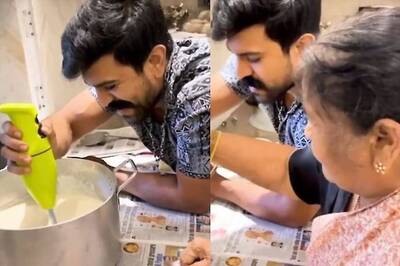
views
Indian skilled workforce can easily be divided into three categories – primary, secondary and tertiary. Primary skilled workforce consists of those who are matriculates, school drop outs or even illiterates but work as barbers, cooks, mansions, carpenters or plumbers, thanks to the experience they have gained by virtue of hard work. Secondary skilled workforce mainly comprises youths who have some degrees or certificates but without any certified exposure or experience in sync with their skills. The last category is certainly those who have higher education degrees, skills, ability to articulate or visualise and execute or achieve work targets at a level which leads to the creation of assets or capital.
Still, we are not in a cheerful situation. An estimate suggests that India added 4.5 lakh employees to the tech workforce during 2021-22 fiscal. A report by Nasscom-Zinnov says that India will face a shortage of 14-19 lakh tech professionals by 2026. As compared to the current 46 lakh tech workforce in the country, India needs 52 lakh tech professionals. By 2026, as per the report, India is estimated to have 75-78 lakh tech professionals. However, the requirement is being pegged at 93-96 lakh techies, reflecting a gap of 14-19 lakh tech workforce. CII’s ‘Decoding Job Report 2022’ talks of comprehensive collaboration between industry and academia. Educational institutes lack in providing industry-relevant skills to students.
It is a proven fact that our youth carrying degrees of higher education are not well skilled. Quite often, we also read in newspapers how post-graduates, graduates and research scholars apply for clerical government jobs. I can recall the days when qualified people used to apply for the Mahatma Gandhi National Rural Employment Guarantee Act (MNREGA) cards presuming that they will get them some fixed amount every month from the government without any work. There is an important takeaway from this, which is relevant even today, and an important issue to ponder over. It is the employability of our youths who are armed with degrees conferred upon them by higher education institutions (HEIs) but they are not equipped with employable skills.
I am not questioning either their abilities or the quality of education imparted to them by their alma maters. However, as an expert and an employer, I wonder if they will ever get a job on the basis of their degrees. Some of them will do some professional or add-on courses to acquire some employable skills. For example, B. Com students will upgrade their accounting knowledge to get some jobs. Similarly, students of Pure Sciences or those who have done liberal studies will do B. Ed so that they become teachers if they do not get government jobs. It is here that we are seriously erred. It is nowhere written or proven that students of Humanities cannot become a skilled workforce. We’ve wrongly presumed that skills are not meant for all. Let me disagree. Today skills are needed by all.
The Union Ministry of Education recently released the National Institution Ranking Framework-2022 (NIRF-22). Union Minister of Education, Skill Development and Entrepreneurship Dharmendra Pradhan was quoted saying in an official note that “a robust and objective framework for assessment, accreditation and ranking will play a major role in enhancing quality in the higher education ecosystem …We are moving towards creating a knowledge-based economy which is innovation-led and technology-driven. Our higher educational institutions have to play a key role in making India a leading global innovation and digital economy and making quality education affordable and accessible for the bottom of the pyramid population.”
Five broad categories of parameters identified in the NIRF are teaching, learning and resources; research and professional practice; graduation outcomes; outreach and inclusivity, and perception. Skills or entrepreneurial skills are not a parameter.
Indian Institute of Technology Madras retained its first position in ‘Overall Category’ for the fourth consecutive year and in ‘Engineering’ for the seventh consecutive year. Interestingly, top 100 academic institutions in the overall category consists of 40 centrally funded technical institutions (CFTIs) and centrally funded universities (CFUs) including 38 technical institutions, 26 state universities, 24 deemed universities, six private universities, seven medical institutions and three management institutions. Indian Institute of Science, Bengaluru topped the ‘Universities Category’ while IIM-Ahmedabad topped the ‘Management’ subject and All India Institute of Medical Sciences (AIIMS), New Delhi occupied the top slot in medical for the fifth consecutive year. IIT, Roorkee stood at the first position in architecture subject for the second consecutive year.
We see that technical institutions where skill and knowledge-based top-quality education is imparted occupy an important slot in the NIRF ranking. India’s ranking in Global Innovation Index has also significantly improved from 76 in 2014 to 46 in 2021. However, in order to improve the culture of innovation and entrepreneurship, we need to educate our students in a way that not only enhances their knowledge but also provides the skill to live a fulfilling and useful life. It should happen in all HEIs, and not just a few hundreds of them.
No doubt, the National Education Policy 2020 lays down the roadmap for the 21st century education system. Synergy between education and skills is creating a new ecosystem. We are certainly striving our best to make learning more vibrant, harness Industry 4.0 and sow the seeds for shaping the destiny of India@100 but are we really aligned to global trends and future challenges remains a million-dollar question.
To excel in the 21st century labour market, India needs a comprehensive skill set composed of cognitive skills, which encompass the ability to understand complex ideas, adapt effectively to the environment, learn from experience, and reason; socio-emotional skills, which describe the ability to navigate interpersonal and social situations effectively; technical skills needed to perform a specific task; and digital skills, which are cross-cutting.
Are our HEIs aligned to withstand the present and future challenges of the labour market? Is there a complete alignment between relevance and efficiency of technical knowledge, which our youths are getting in HEIs? No, there is not. There are critical gaps, which we need to admit and we ourselves are to be blamed for those. We are paying the price for being routine in our approaches towards education in general, and skill education in particular.
Look at some of the countries, which are known for their skilled workforce. Japan tops the list followed by South Korea, Germany, China, United Kingdom, United States, Canada, Norway, Switzerland, Singapore and so on. They have invested a lot in their higher education. The way China has skilled its masses is remarkable. They can make anything or everything whatever is used on this planet. Switzerland is blessed with the most skilled workers, enjoying very low crime rates, clean cities, minimal homeless population, clean air and beautiful landscapes. Look at Singapore, whose education system produces a large, reliable workforce every year.
Predominant industries in Sweden are telecommunications, industrial machines, chemical goods, pharmaceuticals, motor vehicles, precision equipment, iron and steel, and home goods and appliances; all skilled based. Denmark boasts of some world-leading advanced industries with a major focus on maritime shipping, pharmaceuticals, and renewable energy. The country has a highly educated and well-informed population, with international schools across the country. The message is loud and clear. Fast-paced sustainable growth with marked improvement in people’s life can be possible only when we create a highly skilled workforce for which our HEIs have to rise to the occasion so that their alumni must justify their degrees and make the most of their talents in building a new India.
The writer is Co-Founder and MD, Orane International, training partner with National Skill Development Corporation (NSDC), Network Member, India International Skills Centres, an initiative of GoI. The views expressed in this article are those of the author and do not represent the stand of this publication.
Read the Latest News and Breaking News here




















Comments
0 comment